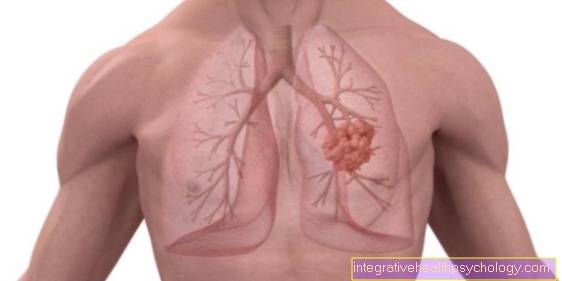Treatment of scarlet fever
introduction
Scarlet fever is a condition that occurs due to infection with streptococci, a type of bacteria.
Typical symptoms are high fever, body aches, sore throat, swollen tonsils, and headache. Characteristically, a raspberry tongue (shiny red) and a skin rash with perioral pallor appear, i.e. a rash that spares the mouth.
The treatment consists of the administration of antibiotics and the additional therapy of the symptoms with antipyretic and pain relievers. The main goal of therapy is to prevent serious complications.

What treatment options are there?
-
antibiotic
-
penicillin
-
Erythromycin
-
Clarithromycin
-
-
Fever reducers / pain relievers
-
Paracetamol
-
Ibuprofen
-
Lozenges for a sore throat
-
Home remedies (tea, wraps)
-
These antibiotics are used
The primary antibiotic used for scarlet fever is penicillin V. This can be given in tablet form.
If you have allergies to penicillin, other antibiotics such as erythromycin or clarithromycin can be used. About three days after the start of antibiotic therapy, you are usually no longer contagious, but the therapy should be carried out for ten days. Because of the serious complications that scarlet fever brings with it, the condition is always treated with antibiotics.
Read more on the topic: penicillin
Which antibiotic is the best?
The most suitable antibiotic for scarlet fever is penicillin, which has been known for a long time.
There are now various subclassifications of this antibiotic, usually penicillin V is used. Since there are many allergies to penicillin in particular, the use of other medications is often appropriate. So-called macrolide antibiotics are usually used for this.
You might also be interested in this topic:
- Treatment with antibiotics
- Side effects of antibiotics
Treatment without antibiotics
Treatment of scarlet fever without antibiotics is usually aimed at strengthening the body's individual defenses so that it can defend itself against the disease.
This includes, for example, calf wraps if you have a fever. Like antipyretic drugs, these can lower body temperature. However, they do not suppress the fever but only help the body to lower the temperature more quickly at the right moment.
Teas are best for a sore throat caused by scarlet fever. Firstly, they ensure that those affected drink enough fluids. This is especially important in the case of a fever so that the body does not dry out. This is the only way to be strong enough to fight the infection.
Second, the ingredients in teas often contain anti-inflammatory and antibacterial substances. For example, ginger, nettle, lemon or sage tea can be used. A spoonful of honey can be added to the tea to provide additional relief from the sore throat.
Throat candies can also contain these ingredients. Sage pastilles or Icelandic moss are particularly suitable. Nasturtiums can also be taken against the bacteria. Due to the dangerous complications that can occur with scarlet fever, antibiotic therapy is strongly recommended, despite other good treatment options.
Home remedies
Home remedies are primarily used to treat the symptoms of scarlet fever. The triggering bacteria themselves should definitely be treated with antibiotics, otherwise serious complications can occur.
The most pronounced symptom of scarlet fever is fever, which can also result in chills. A sufficient supply of fluids is particularly suitable as a home remedy. Tea, juices and chicken soup or vegetable broth can be used for this. If the fever is particularly high, cold leg compresses are a good way to relieve symptoms. However, these should not be used if the affected person is currently having chills or if the hands and feet are cold.
Sore throats, which can also occur as part of the scarlet fever infection, are usually treated well with cold tea.
For example, ginger tea with honey is well suited to relieve sore throats. The tea contains anti-inflammatory substances that fight the bacteria and at the same time relieve the pain in the throat. Cold or warm towels can also be wrapped around the neck (depending on what is more comfortable for the affected person) to alleviate the symptoms. Warm compresses can be used to relieve muscle pain. Joint pain, on the other hand, is best treated with cold. Cold compresses, quark or cabbage compresses can be used for this.
homeopathy
In the case of an infection with scarlet fever, homeopathic remedies can be used to support the therapy.
Belladonna, Phytolacca americana and Apis mellifica work well against fever and sore throats. Ipecacuanha is used when nausea and vomiting occur.
Since scarlet fever can cause serious complications, antibiotic therapy is highly recommended, despite some legitimate concerns. Compared to antibiotics, antibiotics offer much better protection against the sometimes life-threatening long-term effects.
Duration of treatment
Treatment for scarlet fever is with antibiotics and should be carried out over a full 10 days.
Since serious complications can occur without adequate therapy, the 10-day treatment must be carried out completely to the end. If treatment is discontinued early, organ diseases of the heart, liver, kidneys and brain can occur despite antibiotics. These can be life-threatening and have lifelong consequential damage.
You might also be interested in this topic: This is how long scarlet fever usually lasts
What Can Happen If Scarlet Fever Is Not Treated?
The complications of strep infections such as scarlet fever can have serious consequences that can lead to organ failure and even death. The complications mainly occur when the immune system reacts strongly to the infection and a few weeks after the actual scarlet fever disease begins to turn against the own body. This post-streptococcal syndrome can affect the heart, liver, kidneys, joints, and brain.
In the context of acute rheumatic fever, the heart muscle or the inner lining of the heart is infected. This can lead to cardiac insufficiency and heart valve disease, which are life-threatening without treatment. The liver and kidneys can also be severely affected and even fail after an infection with scarlet fever. In this case, antibiotic therapy must be given, and sometimes a kidney replacement procedure (dialysis) must be used temporarily to treat the complications.
Joints are usually also affected when it comes to rheumatic fever. A so-called polyarthritis occurs, in which individual large joints can alternately pain severely. In the brain, scarlet fever can cause diseases such as PANDAS, chorea minor and Tourette's syndrome. All of these complications can result in lifelong limitations, and if left untreated, they are often fatal. Therefore, adequate treatment of scarlet fever is essential.
For more information, see: Complications of scarlet fever





























